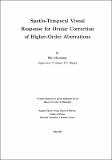| dc.description.abstract | With the development of control aberration using adaptive optics (AO), particular
emphasis has been given recently to the impact of higher-order aberrations (HOAs)
on visual performance, with a view to improved refractive corrections, for example
using customised intra-ocular lenses (IOLs). However, to date most studies have
used simple static visual tasks, whereas more complex realistic tasks are required to
reveal the spatio-temporal complexity of the human visual response.
In this Thesis, we start by performing an introductory study of spherical versus
aspheric IOL design, in which the need for exact ray-tracing is emphasised, demonstrating
the significance of higher-order aberrations in post-operative surgery correction
as well as in realistic eye models.
Turning to visual characterization of HOAs and their predictability by metrics, the
development of a new adaptive optics vision simulator is addressed. We describe
the design, construction and testing of this AO system. In an experiment in which
we correct the natural aberrations of the eye, and introduce fixed amounts of pure
Seidel aberrations, we measure how the pyschophysical visual acuity changes and
compare the results with metrics. By combining the aberration control of this new
system with computational manipulations of the spatio-temporal stimulation based
on advanced attentional paradigms, we show that the perceived degradation by
HOAs is a distinctly sensitive response that varies with the nature of the stimulation
and the spatio-temporal pathway visually excited. This study concludes that
aberrations not only affect absolute visual performance, but also may adjust the
mediative mechanism that articulates spatial and temporal visual representations.
This novel result has important consequences for the expansion and assessment of
customized refractive correction, and provides a new method for understanding cortical
plasticity and visual function. | en_US |


